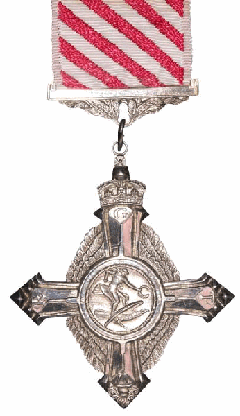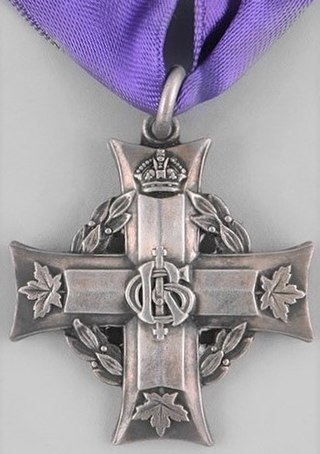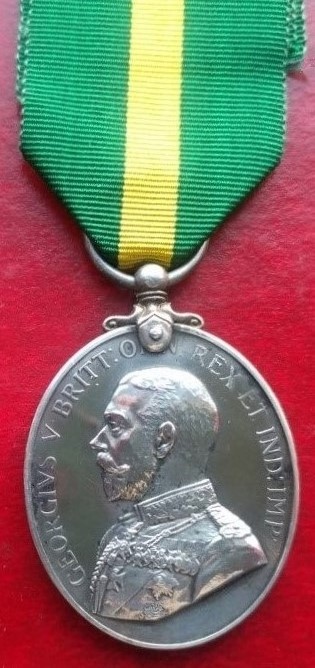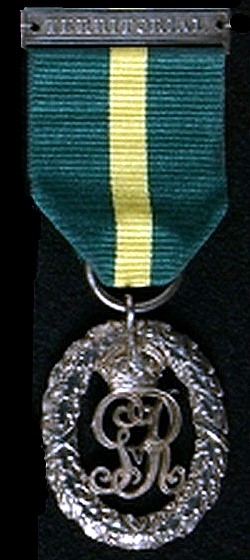
The Distinguished Flying Cross (DFC) is the third-level military decoration awarded to officers, and since 1993 to other ranks, of the United Kingdom's Royal Air Force and other services, and formerly to officers of other Commonwealth countries, for "an act or acts of valour, courage or devotion to duty whilst flying in active operations against the enemy".

The Distinguished Service Cross (DSC) is a third-level military decoration awarded for gallantry during active operations against the enemy at sea to officers; and, since 1993, ratings and other ranks of the British Armed Forces, Royal Fleet Auxiliary and the British Merchant Navy have been eligible. The award was formerly also awarded to members of armed forces of other Commonwealth countries.

The Distinguished Service Medal (DSM) was a military decoration awarded until 1993 to personnel of the Royal Navy and members of the other services, and formerly to personnel of other Commonwealth countries, up to and including the rank of Chief Petty Officer, for bravery and resourcefulness on active service at sea.

The Air Force Cross (AFC) is a military decoration awarded to officers, and since 1993 other ranks, of the British Armed Forces, and formerly also to officers of the other Commonwealth countries. It is granted for "an act or acts of exemplary gallantry while flying, though not in active operations against the enemy". A bar is added to the ribbon for holders who are awarded a further AFC.

The Queen Elizabeth II Golden Jubilee Medal or the Queen's Golden Jubilee Medal was a commemorative medal created in 2002 to mark the 50th anniversary of Queen Elizabeth II's accession in 1952. The Queen Elizabeth II Golden Jubilee Medal was awarded in Canada to nominees who contributed to public life. The Queen's Golden Jubilee Medal was awarded to active personnel in the British Armed Forces and Emergency Personnel who had completed 5 years of qualifying service.

The Memorial Cross, often known as the Silver Cross for Mothers, is a Canadian decoration awarded to the mother, widow, widower, or next of kin of any member of the Canadian Armed Forces whose life is lost on active service, including peacekeeping, other such international operations and, since 2001, other service-related deaths.

The Order of Burma was founded by Royal Warrant on 10 May 1940, and conferred in a single class. It was awarded by the Governor of British Burma for long, faithful and honourable service by Governor's Commissioned Officers in the Burma Army, the Burma Frontier Force and the Burma Military Police. In September 1945 the royal warrant was amended to permit awards of the order for gallantry.

The 1914–15 Star is a campaign medal of the British Empire which was awarded to all who served in the British and Imperial forces in any theatre of the First World War against the Central European Powers during 1914 and 1915. The medal was never awarded singly and recipients also received the British War Medal and Victory Medal.

The Zimbabwean Independence Medal, 1980 was instituted on 17 April 1980 for award to those who were involved in the Zimbabwean independence process or commemorations in some way.

The Emergency Reserve Decoration (ERD) was a British military decoration for long service, instituted on 17 November 1952 and given for service up to 1967.

The China War Medal 1900 was a British campaign medal approved on 1 January 1902 for issue to British and Indian land and sea troops who served during the Boxer Rebellion, between 10 June and 31 December 1900. The medal was issued in silver to combatants and in bronze to native, namely Indian, bearers drivers and servants.

The Korea Medal, sometimes referred to as the Queen's Korea Medal to distinguish it from the United Nations Service Medal, is a campaign medal created in 1951 to recognize troops from Australia, Canada, New Zealand, and the United Kingdom who had given either one day's service in an air sortie over Korea, or 28 days service offshore, during the Korean War. The medal was identical in all countries where it was awarded, except for Canada where it contained unique elements. An award distributed across the Commonwealth, the Korea Medal holds a different place in each country's order of precedence for honours.

The Canadian Volunteer Service Medal is granted to persons of any rank in the Naval, Military or Air Forces of Canada who voluntarily served on Active Service from September 3, 1939, to March 1, 1947. The medal was established on October 22, 1943.

The Rhodesia Medal was initiated by the British Government in consultation with Australia, New Zealand, Fiji and Kenya, whose forces took part in Operation AGILA. The role of the multi-national force was to keep peace between 22,000 guerrilla fighters and the Rhodesian forces during the ceasefire and run-up to the 1980 elections.

The Decoration for Officers of the Royal Naval Reserve, commonly known as the Reserve Decoration (RD) was a medal awarded to officers with at least fifteen years service in the Royal Naval Reserve (RNR) of the United Kingdom. The medal was instituted in 1908.

The Territorial Force Efficiency Medal was a United Kingdom award for long service in the Territorial Force between 1908 and 1921.

The Efficiency Decoration, post-nominal letters TD for recipients serving in the Territorial Army of the United Kingdom or ED for those serving in the Auxiliary Military Forces, was instituted in 1930 for award to part-time officers after twenty years of service as an efficient and thoroughly capable officer. The decoration superseded the Volunteer Officers' Decoration, the Colonial Auxiliary Forces Officers' Decoration and the Territorial Decoration.

The Service Medal of the Order of St John is awarded to recognise both conspicuous and long service with the Venerable Order of St John, particularly in St John Ambulance, both in the United Kingdom and in a number of other Commonwealth countries and Hong Kong. The award was announced in the St John Ambulance Brigade General Regulations for 1895 and minted in 1899, though the first honourees had been selected the previous year.

The Southern Rhodesia Service Medal 1939–1945 was a campaign medal of the British Commonwealth. It was awarded to members of the Southern Rhodesia Defence Forces for home service during World War II.

The New Zealand Defence Service Medal (NZDSM) is a military service medal awarded to former and current members of the New Zealand Defence Force, for qualifying service since 3 September 1945. It is expected that at least 160,000 former service personnel and more than 7,000 currently serving NZDF personnel are eligible to receive the medal.





















